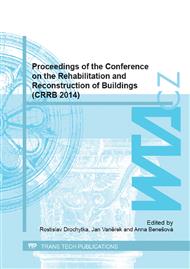p.161
p.165
p.169
p.173
p.177
p.181
p.185
p.191
p.195
Non-Destructive Defectoscopy of Building Structures by Pulsed Thermography
Abstract:
At present there are many diagnostic methods for the detection of different defects in building structures. Destructive methods, which do not enable purposeful redevelopment action or a potential cause prediction of the defect without damage to the structure, are mostly used. Pulsed thermography consists in rapid (pulse) external or internal heating of the element and the subsequent evaluation of the temperature field on the surface of the element with the thermal imaging camera. A pulse method is divided into the reflective and passes according to the arrangement of the heating source, object and thermal imaging camera. The surface temperature is changing rapidly, driven by pulse stimulation due to scattering of thermal wave, radiation and convection. The paper focuses on the possibility of using pulsed thermography in the detection of various defects in building constructions.
Info:
Periodical:
Pages:
177-180
Citation:
Online since:
August 2015
Authors:
Price:
Сopyright:
© 2015 Trans Tech Publications Ltd. All Rights Reserved
Share:
Citation:


